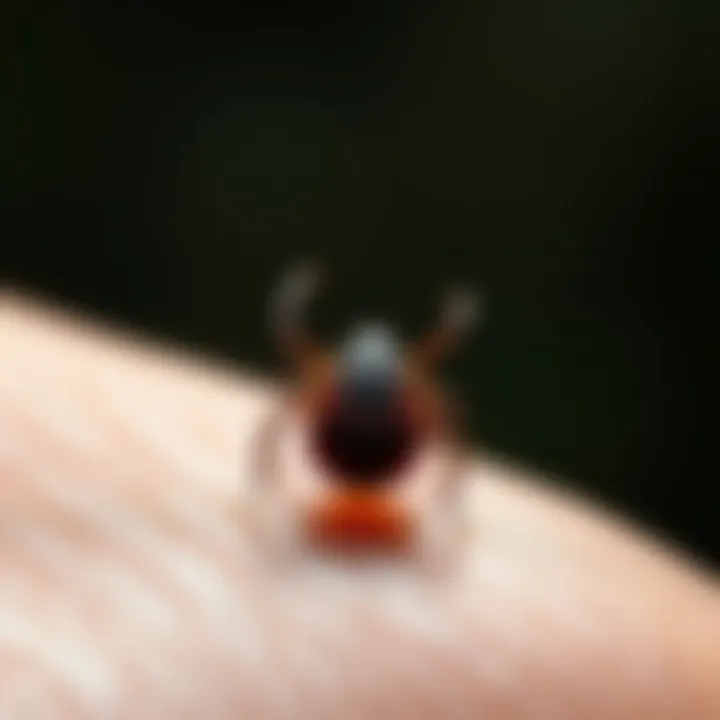Identifying Tick Bites: Signs and Health Risks


Intro
Tick bites are not just a minor annoyance; they can carry significant health risks that often go unnoticed until serious complications arise. Understanding the nuances of tick bites—how to identify them, what symptoms to look for, and the implications of potential diseases—is crucial for anyone who frequently ventures into wooded areas or natural settings. Whether you're a forestry professional ensconced in the woods, a nature enthusiast, or someone who simply enjoys a weekend hike, knowledge about ticks is an armamentarium against unexpected health threats.
Furthermore, the prevalence of ticks in various regions can fluctuate based on ecological factors, making it essential to stay informed about their habits and habitats. Identification is the first step towards treatment and prevention. By recognizing the signs of tick bites and understanding what follows, individuals can equip themselves to mitigate risks effectively. This article aspires to unfurl the intricacies surrounding tick bites, from the initial identification to the broader health implications, while delving into prevention strategies that can safeguard our health and well-being in the great outdoors.
Prolusion to Tick Bites
Tick bites may not always seem like a pressing concern, yet understanding their implications is crucial. This section serves as a gateway into the often overlooked but significantly impactful world of tick bites. Since ticks are common in many environments—particularly wooded areas—many professionals, especially forestry workers and outdoor enthusiasts, may encounter them frequently. Thus, recognizing a tick bite promptly can be the difference between a fleeting irritation and a serious health risk.
When a tick latches onto the skin, it can transmit various diseases, including Lyme disease and Rocky Mountain spotted fever. Each tick species has its own set of potential health risks associated with its bite. Hence, embracing a proactive approach towards identifying these bites is vital. Knowing the signs and symptoms can help individuals gauge their situation swiftly.
Benefits of Understanding Tick Bites:
- Knowledgeable individuals are empowered to check themselves or others systematically after outdoor activities, reducing health risks.
- Early identification of tick bites can lead to timely medical intervention, which is key in preventing diseases.
- Understanding the environment where ticks thrive aids in making better choices regarding safety and prevention.
Moreover, gaining insight into tick bites encourages informed discussions within professional circles. Whether it’s sharing tips about prevention or recounting personal experiences regarding symptom recognition, pooled knowledge can serve to benefit all involved. In the forestry sector, the health of workers is paramount, and recognizing tick bites can enhance safety protocols and ultimately preserve workforce well-being.
"An ounce of prevention is worth a pound of cure." This adage rings particularly true in the context of tick bites; understanding their implications allows for preventive measures that can save much trouble down the line.
In summary, this introductory overview lays the groundwork for what follows in the article. By diving deeper into the types of ticks, the characteristics of their bites, and the potential health implications, we aim to arm you with the knowledge needed to navigate the risks posed by these tiny yet formidable creatures.
Understanding Ticks
Ticks are more than just a nuisance in the great outdoors; they are vectors for serious diseases that can impact human health and animal welfare. Understanding ticks is pivotal for anyone who spends time in forests or wooded areas, as this knowledge equips individuals to recognize the threats and mitigate risks associated with ticks. This section dives into their biology, classification, and lifecycle, breaking down the essential components that contribute to the broader topic of tick evaluation and management.
Types of Ticks
Ticks fall into two primary categories: hard ticks and soft ticks. Each type presents unique characteristics which warrant careful consideration for those involved in forestry or outdoor activities.
Hard Ticks
Hard ticks, scientifically classified under the family Ixodidae, are notorious for their role in transmitting diseases like Lyme disease. One of their most notable characteristics is the shield-like scutum on their back, which distinguishes them from soft ticks. This feature plays a significant role in their survival, as it aids in water retention and offers some protection against desiccation.
Moreover, hard ticks have a longer feeding duration, often lasting several days, which increases the chances of disease transmission. While this prolonged attachment can be troublesome, it also allows the host to become more aware of the tick's presence, should they feel an unusual itch or discomfort. Their lifecycle predominantly includes multiple stages—larval, nymphal, and adult—that are each crucial in understanding the timing of potential Lyme disease outbreaks. Ultimately, recognizing hard ticks in their various forms aids forestry professionals in taking preventive actions.
Soft Ticks
In contrast, soft ticks belong to the family Argasidae. They lack that distinct scutum, giving them a more rounded appearance. One key characteristic of soft ticks is their tendency to feed relatively quickly, often in a matter of minutes as opposed to days. This swift feeding can lead to accidental bites being overlooked, making it crucial for individuals to stay vigilant.
A unique feature of soft ticks is their ability to reproduce in a more sporadic manner compared to hard ticks, which generally adhere to a predictable lifecycle. This adaptability can complicate the assessment of their populations in a given area. Soft ticks are often less recognized as disease carriers; however, they can transmit tick-borne diseases, such as Tick-borne Relapsing Fever, presenting a risk that shouldn’t be ignored.
Lifecycle Stages
Understanding the lifecycle stages of ticks is vital for recognizing their threats effectively. Ticks undergo four distinct stages: egg, larva, nymph, and adult. Each stage presents different opportunities for intervention and management.
The eggs are laid in the spring and hatch into larvae, which are generally the smallest and often the hardest to detect. Once they find a host, they feed and then drop off to molt into nymphs. This stage is particularly dangerous, as nymphs are often the size of a poppy seed but come with a proclivity for biting humans during peak outdoor activity. By the time they reach adulthood, ticks have usually increased in size and may be easier to spot, but an adult tick's bite can yield greater health implications, especially concerning transmitted diseases.
This intricate lifecycle underscores the importance of monitoring tick populations throughout various seasons. Such vigilance is critical for anyone engaged in forestry activities, as it directly relates to managing the risks associated with tick bites and the diseases they can carry.
"Awareness and understanding of tick biology is the first step toward effective prevention and management in tick-prone environments."
By comprehensively charting the characteristics and impacts of ticks, forestry professionals become better equipped to protect themselves and the broader ecosystem from the implications of tick bites.
Characteristics of Tick Bites
Understanding the characteristics of tick bites is crucial for anyone who spends time in natural environments, whether in forests, fields, or even your own backyard. Identifying these bites promptly can prevent complications associated with tick-borne diseases. Fundamental elements of tick bites include physical appearance, symptomatology—how they affect the body, and the distinct behaviors of the host towards these bites.
Physical Appearance
Redness and Swelling
Redness and swelling around a tick bite are typical reactions from the body to the bite itself. When you see these symptoms, it's an indicator of inflammation, which happens when the immune system engages with potential pathogens introduced with the tick's saliva. The hallmark of redness is its localized nature—appearing only around the site of the bite and often accompanied by heat. This distinctive characteristic helps differentiate tick bites from others, where swelling may not be as pronounced. However, a potential drawback to this indicator is that not everyone will display these symptoms the same way, depending on various factors, including the individual’s prior exposure to ticks.
Bite Location
The location of a tick bite is insightful in identifying a tick’s presence. Ticks often latch onto warm, hidden places on the body like behind the knees, in the armpits, or even around the hairline. Unlike mosquito or flea bites, which can occur almost anywhere, ticks prefer these tucked-away spots, making this feature valuable for diagnosis. The unique aspect of spotting ticks in these locales is that it suggests a higher exposure risk, as these areas are less likely to be checked for bites. Noticing a tick in these spots early can lead to quicker removals, minimizing health risks.
Distinctive Marks
Each tick bite can manifest with specific marks that offer clues to its identity. For instance, the presence of a “bull's eye” rash is a classic sign associated with Lyme disease, a severe implication of tick bites. This particular feature not only serves as a diagnostic tool but also calls for immediate attention. However, not all ticks produce visible characteristics, and some individuals may not develop any distinctive marks until later stages. This variability can lead to misinterpretations and delayed responses, stressing the importance of awareness of these specific signs.
Symptomatology
Local Reactions


Local reactions to a tick bite may include itching, warmth, or mild pain confined to the bite area. These symptoms are typically mild and transient but can provide essential insights into the body’s initial response. Recognizing local reactions can help one monitor changes over time, as not all reactions mean immediate issues. Contrarily, localized symptoms can also be a sign of an allergy to tick saliva or a subsequent infection, thereby spotlighting the need for observation post-bite.
Systemic Symptoms
Beyond localized reactions, systemic symptoms may emerge based on tick species and diseases transmitted. These can include fever, fatigue, and muscle aches—wide-ranging signals that something might be off with one’s health. The identifying feature here is that systemic symptoms usually develop several days after the bite. This delay can complicate matters, as individuals may not make the connection between a tick bite and emerging symptoms immediately, emphasizing vigilance in keeping track of any bites sustained during outdoor activities.
Signs of Infection
Infections from tick bites can manifest through various signs, such as increased redness, pus formation, or severe pain. Recognizing these signs is vital because they signal the body’s battle against infection, which can escalate without timely intervention. The unique feature of infection symptoms is that they often do not arise until hours or even days post-bite, creating a window for possible complications. Prompt identification of these warning signs can save one from escalated health issues, proving yet again the importance of awareness in the management of tick bites.
"Awareness isn’t just a keyword; it’s the lifeline in preventing tick-borne diseases."
Understanding tick bites through their characteristics empowers individuals in high-risk areas by enabling quick responses to potential threats, leading to better health outcomes.
Differentiating Tick Bites from Other Insect Bites
Identifying tick bites from other insect bites can be a crucial skill for anyone spending time outdoors. Misdiagnosing a tick bite could lead to untreated conditions that may have serious health implications. Understanding the differences not only aids in proper treatment but also helps in managing any potential diseases that ticks might spread.
Key Indicators
Timing of Symptoms
The timing of symptoms after a bite can be indicative of whether a tick has bitten or if another insect is responsible. Tick bites often take longer to present noticeable symptoms than those from mosquitoes or fleas. For instance, while mosquito bites may show immediate swelling and itchiness, tick manifestations can take hours or even days to arise. This delay allows the tick to attach and begin transmitting pathogens. Recognizing this timing might help individuals gauge the likelihood of a tick bite, particularly for those engaged in activities in wooded areas or long grass.
Specificity of Reaction
Another telling aspect in distinguishing tick bites is the specificity of the reaction. Tick bites sometimes cause a distinctive shaped rash or a particular localized sensitivity. In contrast, bites from mosquitos or fleas provoke a more generalized itchy response. A unique feature with tick bites is the presence of a bull's-eye rash in cases of Lyme disease, which does not occur with other insect bites. This characteristic can be pivotal for timely diagnosis and treatment of tick-borne illnesses, positioning tick bites as markedly different from their insect counterparts.
Persistence of Symptoms
When it comes to the persistence of symptoms, tick bites might leave behind signs that last longer than those from other insects. For example, redness and irritation from a tick bite can linger, suggesting that the bite site may be more prone to infection or allergic reactions compared to other insect bites that often subside within days. Monitoring the duration of symptoms can play a vital role in determining the proper course of action, such as seeking medical help sooner rather than later, ensuring that any potential disease symptoms are not overlooked.
Common Misidentifications
When considering tick bites, misidentification can often occur, leading to a failure to address the specific health risks associated with tick-borne diseases. Understanding common misidentifications is essential for prevention and care.
Mosquito Bites
Mosquito bites are typically characterized by small, raised, itchy welts, appearing quickly after a bite. They are usually fleeting in their irritation, often relieved by topical creams or antihistamines. However, unlike tick bites, they do not have a prolonged course of symptoms. It's crucial to note that while mosquito bites can cause discomfort, they typically do not carry the same level of disease risk as ticks, making their differentiation key for someone who’s particularly susceptible to tick-transmitted diseases.
Spider Bites
Spider bites may sometimes be confused with tick bites due to similar symptoms, such as localized redness and swelling. However, a marked feature of spider bites is the potential for systemic reactions, including severe pain or necrosis, depending on the spider species involved. This differentiates them in the way they are treated versus tick bites. Recognizing the distinct features of a spider bite can effectively reduce anxiety over tick-borne risks.
Flea Bites
Flea bites often appear in clusters, particularly around the ankles and lower legs. They have a distinctive itchy quality but typically do not present the same severity of redness or prolonged symptoms as tick bites. Moreover, flea bites can often be decreased with household cleaning measures, while tick bites may necessitate more vigilant health measures due to their potential for serious health implications. Understanding these differences is vital in ensuring the right management approach is taken.
Health Implications of Tick Bites
The significance of understanding the health implications of tick bites cannot be overstated. These small arachnids are not just a nuisance; they can carry and transmit serious diseases that affect both human health and animal welfare. If a tick bite goes unnoticed or untreated, it can lead to complications that may turn manageable symptoms into life-altering conditions. Addressing this topic is essential not only for outdoor enthusiasts but also for professionals who work in wooded areas, such as forestry workers, landscapers, and even researchers. Being informed about these health implications allows individuals to take proactive measures and engage in better risk management.
Diseases Transmitted by Ticks
Ticks are known vectors for a variety of diseases, each presenting unique challenges and implications for health. Here, we explore some of the most prevalent tick-borne diseases.
Lyme Disease
Lyme disease stands out as one of the most notorious tick-related illnesses. It is primarily transmitted by the black-legged tick, commonly called the deer tick. The key characteristic of Lyme disease is its ability to produce a circular, red rash often resembling a 'bull's-eye.' This distinctive sign makes Lyme disease particularly notable in discussions about tick bites because early recognition can result in effective treatment.
The unique aspect of Lyme disease is that, when caught early, it is treatable with antibiotics, leading to a favorable prognosis. However, failure to address the infection promptly can result in serious complications, further emphasizing the need for awareness. Understanding Lyme disease also aids in educating those who frequent wooded areas, enhancing their ability to identify symptoms early.
Rocky Mountain Spotted Fever
Rocky Mountain spotted fever (RMSF) brings to light another crucial concern associated with tick bites. Transmitted mainly by the American dog tick, RMSF is characterized by sudden onset of fever and a distinctive rash that may develop into spotted or petechial lesions. This aggressive disease is important to recognize because it can progress rapidly, becoming life-threatening within days if not treated.
The unique feature of RMSF is the combination of fever and rash which can be mistaken for other conditions. Prompt diagnosis is vital, as timely antibiotic treatment can significantly reduce fatality rates. RMSF's aggressive nature and the potential misconceptions about its symptoms make it a popular choice in discussions concerning tick bites, particularly for professionals exposed to high-risk environments.
Anaplasmosis
Anaplasmosis, although perhaps less well-known than the other two diseases, is nonetheless a significant health risk. Transmitted by the same ticks that carry Lyme disease, anaplasmosis often presents with flu-like symptoms, including fever and muscle aches. One of the standout features of anaplasmosis is that it can sometimes occur simultaneously with Lyme disease, complicating diagnosis and increasing health risks.
The disease is noteworthy for its ability to cause severe symptoms in otherwise healthy individuals if not identified early. While the treatment options are similar to those for Lyme disease, the overlapping symptoms can lead to confusion and delays in obtaining care. This underlines the need for education and awareness regarding the signs and implications of anaplasmosis.
Indicators of Serious Complications


It's essential for individuals who have been bitten by a tick to be vigilant regarding potential complications stemming from these bites. Understanding the signs that suggest the need for immediate medical attention is crucial.
Neurological Symptoms
Neurological symptoms, which may manifest as headaches, dizziness, or even paralysis, are an indication that a tick-borne illness could have progressed. These symptoms can be alarming, and their presence signifies the need for urgent medical evaluation. Recognizing these signs early can be the difference between a full recovery and serious complications. For those working in tick-heavy environments, this knowledge underscores the critical importance of prompt action following a tick bite.
Systemic Reactions
Systemic reactions to tick bites can vary widely among individuals, with some experiencing fever and fatigue, while others may develop more severe manifestations, such as organ dysfunction. Understanding these reactions helps in recognizing when a bite has moved beyond the initial localized effects. Awareness of systemic symptoms can encourage individuals to seek medical advice sooner, therefore mitigating more serious health risks associated with untreated infections.
Chronic Pain
Chronic pain is another serious concern for individuals suffering from tick-borne diseases. Some may experience prolonged pain conditions even after the infection is resolved, a phenomenon sometimes referred to as post-treatment Lyme disease syndrome. This aspect highlights the importance of continuous monitoring and follow-up care after treatment, ensuring that individuals receive the necessary support to manage any lingering symptoms.
In summary, understanding the health implications associated with tick bites, including the diseases they transmit and indicators of serious complications, is paramount for those in higher-risk professions. Knowledge is power, and being equipped to recognize the signs not only empowers individuals to protect themselves but also potentially saves lives.
Preventative Measures Against Tick Bites
Awareness and preparation are key when it comes to preventing tick bites. Understanding how to minimize exposure not only protects individuals but also promotes overall health in environments prone to these pests. There are several practical strategies that can be employed to reduce the likelihood of encountering ticks and to mitigate the risks associated with their bites. By implementing these preventative measures, outdoor enthusiasts and forestry professionals can significantly lower their chances of tick-related health issues.
Best Practices in Tick Prevention
Wearing Protective Clothing
One of the simplest yet most effective ways to guard against tick bites is by donning protective clothing. When venturing into tick-rich areas, consider wearing long sleeves and pants made of tightly woven fabrics. This choice creates a barrier, making it harder for ticks to reach skin. Light-colored clothing also has advantages; any ticks that latch on are easier to spot. While this method may feel cumbersome in warm temperatures, it remains a highly recommended and practical defense.
- Key characteristic: It’s substantial coverage.
- Benefits: Protects against bites and allows for easier detection of ticks.
- Disadvantages: Potential discomfort in hot weather.
Using Insect Repellents
Another crucial strategy is applying insect repellents that contain DEET or picaridin. These substances are known to provide a significant deterrent against ticks. When choosing a repellent, look for products with a concentration of at least 20% DEET for optimal effectiveness. This measure doesn’t eliminate the chances of a tick bite but significantly enhances your protection level. It is advisable to reapply as per the product’s instructions, especially after sweating or swimming.
- Key characteristic: Chemical repellents that deter insects.
- Benefits: Strong protection against tick bites for extended periods.
- Disadvantages: Some individuals may prefer natural alternatives due to skin sensitivities.
Avoiding Tick-Prone Areas
Steering clear of known tick habitats is a vital preventative measure. This includes tall grasses, brushy areas, and heavily wooded regions. If unavoidable, moving cautiously and sticking to the center of trails can reduce contact with ticks. Education is crucial here; knowing the local environment and the seasons when ticks are more active can greatly influence your ability to stay safe. This preventative measure emphasizes the importance of situational awareness in decreasing exposure to tick bites.
- Key characteristic: Knowledge of local ecosystems and tick behaviors.
- Benefits: Minimizes risk by consciously avoiding high-risk areas.
- Disadvantages: May limit outdoor activities and exploration opportunities.
Post-Outdoor Activity Protocols
Thorough Body Checks
After outdoor ventures, conducting thorough body checks is a non-negotiable practice. Make it a habit to inspect yourself and others for ticks, focusing on areas like behind the ears, underarms, and along the waistline, where ticks might find warm, sheltered spots. This step is crucial; early detection can prevent the serious implications associated with tick bites. Remember, tick bites don’t always result in immediate symptoms, making post-exposure checks vital for health and peace of mind.
- Key characteristic: Focused tick-searching in common areas of attachment.
- Benefits: Early detection and removal of ticks decrease the risk of disease.
- Disadvantages: May seem tedious but is well worth the effort.
Clothing Care
It’s just as important to care for your clothes after time outdoors. Tossing clothing into a hot dryer for at least 10 minutes effectively kills any ticks that might be lingering. Wash clothes in hot water before wearing them again to be sure. This measure reinforces the principles of maintaining a tick-free environment before entering your home.
- Key characteristic: Simple yet effective fabric treatment.
- Benefits: Tagging ticks even before they can bite.
- Disadvantages: Requires attention to detail and extra laundry effort.
Immediate Showering
Taking a shower shortly after outdoor activities can wash away unattached ticks and provides an opportunity to conduct another body check. This step is especially beneficial if your activities involved walking through high-vegetation areas. Using soap to scrub under nails and in hair helps ensure you’re removing any potential threat. Even a quick rinse can help reduce the chances of ticks attaching to the skin.
- Key characteristic: Early post-exposure hygiene practice.
- Benefits: Additional tick detection chance after an outdoor outing.
- Disadvantages: Not always easy to do right away, but should be prioritized.
Steps for Proper Tick Removal
Successfully removing a tick is crucial in minimizing the potential health risks associated with tick bites. The faster one properly extracts a tick, the better chance of preventing disease transmission occurs. Ignoring this step or mismanaging it can lead to complications down the line, some of which may be severe. The following sections distinguish essential tools for safe tick removal and the detailed method to carry out the process itself.
Tools Needed for Safe Removal
Tweezers
Using tweezers for tick removal is often highlighted and for good reason. They provide the precision needed to grasp the tick close to the skin without squeezing. The most distinct characteristic of tweezers is their pointed ends which allows for easy access between the tick and the skin. This specificity makes them a popular choice for such delicate tasks. It's worth noting that not all tweezers are created equal—ideally, ones with straight, pointed tips are recommended for this purpose, as they enhance grip and minimize damage to the tick.
"The key is not to crush the tick while pulling it out; doing so can release harmful pathogens.
Antiseptic Wipes
Antiseptic wipes serve a significant function post-removal, providing a clean surface to prevent any infection at the bite site. These wipes typically contain ingredients like isopropyl alcohol, which effectively disinfects the area. The important aspect to note about antiseptic wipes is that they are easy to use and often readily available in first-aid kits. Their unique feature lies in their simplicity and convenience, making them a staple for outdoor enthusiasts. However, it's crucial to ensure the wipes are not used before removal, as they can irritate the skin prior to tick extraction.


Containers for Disposal
Post-removal, it is essential to have a proper disposal method for the tick. Containers designed for disposal keep the tick secure and prevent contact with other surfaces. The primary characteristic of these containers is the ability to be sealed tightly, limiting interaction with the tick. This is a beneficial choice because it eliminates potential spread of pathogens should the tick show signs of disease. However, be mindful that not all containers are suitable—glass or hard plastic sealed boxes are ideal for this purpose, whereas soft or perforated containers might not be effective.
Detailed Removal Procedure
Grasping the Tick
Grasping the tick correctly is key to reducing the chances of complications. The primary consideration here is to grab it firmly yet gently at its head, close to the skin. This method ensures that you have the best grip while minimizing the risk of head detachment, which can sometimes remain embedded and cause further complications. The unique feature of this technique is that it focuses on maintaining control over the tick and offers the best prospects for a clean removal.
Steady Pulling Technique
The technique used to pull the tick should be steady, without jerking or twisting. This process requires patience, as suddenly yanking can cause the mouth parts to break off and stay in the skin, potentially leading to infection. The characteristic of this technique is its consistency; pulling at a rate that is neither too slow nor too fast reduces the risk of tearing. This steady motion helps ensure that the tick comes out completely.
Following Up with Healthcare Provider
Even after successful removal, it’s prudent to monitor symptoms and consider following up with a healthcare provider. This step is vital in case of any delayed reactions or complications that arise post-treatment. The core aspect of this follow-up is educational; understanding what signs to watch for can help in early recognition of diseases transmitted by ticks. Notably, healthcare professionals can offer tailored advice based on the specific tick species, which may not necessarily be apparent to the average individual.
Home Remedies and Aftercare
Home remedies and aftercare are critical components when dealing with tick bites. Understanding how to manage symptoms effectively at home can make a world of difference. It empowers individuals to handle discomfort while waiting for signs of infection or until they can seek professional medical advice. Knowledge of effective remedies serves as a practical tool to address initial distress, ensuring that tick bites do not significantly disrupt daily life.
Managing Discomfort
Cold Compresses
Cold compresses are often recommended for tick bites, as they can help alleviate swelling and discomfort. The soothing nature of cold packs allows for a localized cooling effect that numbs the area around the bite. This is particularly useful when the itchiness can drive someone up the wall. The key characteristic of cold compresses is their immediate effect; they can be applied within minutes, providing quick relief from the initial reactions that tend to surface after a tick bite. While straightforward in application, just a cloth soaked with cold water will do—there's not much complication here.
However, there are some considerations to keep in mind. While they do reduce swelling momentarily, cold compresses should not be applied for too long to avoid skin damage or frostbite. They are a beneficial choice when the discomfort is mild and manageable, but if the pain or swelling worsens, further medical evaluation may be necessary.
Over-the-Counter Medications
Over-the-counter medications, such as antihistamines and nonsteroidal anti-inflammatory drugs (NSAIDs), are common options for alleviating the symptoms associated with tick bites. Antihistamines can help with itching and swelling, while NSAIDs can address pain and inflammation. Their key characteristic lies in their accessibility—most individuals can easily find these at any pharmacy or even convenience store. This makes over-the-counter medications a popular choice for handling immediate discomfort without needing a prescription.
One unique feature of these medications is their quick onset of action, offering relief within a short period of time. However, users should be aware of potential side effects, such as drowsiness or gastrointestinal discomfort. When considering such options, ensuring the right dosage is crucial to mitigating risks while maximizing relief.
Natural Soothing Agents
Natural soothing agents, like aloe vera or tea tree oil, can also serve as excellent home remedies for tick bites. Aloe vera is well-known for its anti-inflammatory properties. Applying it to a tick bite can promote healing while reducing redness and irritation. Likewise, tea tree oil is praised for its antiseptic qualities, making it a go-to for many seeking a more holistic approach to aftercare. Their appeal in this context is their natural composition; many individuals prefer using products they consider less harsh than pharmaceutical alternatives.
The unique advantage of natural agents lies in their dual functionality—providing both immediate relief and promoting skin health over time. However, users should be cautious with essential oils as they may cause allergic reactions in some individuals. Testing a small area before full application is a wise approach.
Monitoring for Signs of Infection
While managing symptoms at home is vital, vigilance for signs of infection is equally important. Being aware of what to watch for can save someone from a minor problem becoming a significant health concern later on.
What to Watch For
Monitoring what to watch for after a tick bite involves being attentive to the development of symptoms. Common indicators include unusual redness that spreads, persistent swelling, and increased warmth at the site of the bite. Another red flag is the appearance of a bull's-eye rash, often associated with Lyme disease. These signals are crucial because they represent potential progressions towards more serious conditions that could emerge if left unattended.
Being mindful of these changes not only assists in evaluating the current state of the bite but also helps individuals make better decisions about seeking medical intervention when necessary.
When to Seek Medical Help
When to seek medical help is a vital aspect of aftercare following a tick bite. If any of the concerning symptoms previously discussed arise, or if someone develops fever, chills, or flu-like symptoms in the days or weeks following a bite, it is crucial to consult a healthcare provider. The importance of prompt medical attention cannot be overstated—especially considering the diseases that ticks are known to transmit.
Being knowledgeable about the timing for seeking professional assistance can be life-saving, enabling quick identification and treatment of conditions like Lyme disease, which could lead to long-term complications if ignored.
Follow-Up Care
Follow-up care after a tick bite focuses on ensuring that any arising symptoms are adequately addressed and that the overall health trajectory remains stable. This might include scheduled check-ins with a healthcare professional based on the symptoms exhibited or any medications prescribed. One unique feature of follow-up care is that it allows for the observation of any changes over time, ensuring that complications can be quickly addressed.
The overall goal of follow-up is to prevent potential chronic issues associated with tick bites. Being proactive rather than reactive correlates with better health outcomes. This means individuals should not hesitate to return to their healthcare provider if uncertainties or concerns linger post-treatment.
Ending: The Importance of Awareness and Action
Tick bites are more than just an annoyance; they represent a significant health risk that merits attention. Throughout this article, we have examined the characteristics, differentiation, and potential health implications of tick bites. Understanding these elements is key not only for immediate response but also for long-term strategies, particularly for those in forestry and outdoor professions, who are often exposed to tick habitats.
Significance of Awareness
Being knowledgeable about ticks and the diseases they transmit elevates your ability to protect yourself and others. Awareness is the first line of defense. Whether you're working in a dense forest or enjoying a day on hiking trails, recognizing the signs of a tick bite can prevent serious illnesses such as Lyme disease or Rocky Mountain spotted fever.
"An ounce of prevention is worth a pound of cure."
This adage rings particularly true in the context of tick-borne diseases. Taking preventive measures can make all the difference. By being proactive—such as wearing appropriate clothing and using insect repellent—you can significantly reduce your risk of exposure.
Actionable Steps
Once bites are identified, swift action is essential. Applying the proper removal techniques is crucial to avoid transferring pathogens from the tick to the host. Moreover, monitoring oneself for symptoms following a tick bite is indispensable. Individuals must remain vigilant and consider scheduling follow-ups with healthcare professionals if any concerning symptoms manifest.
In terms of public health, promoting awareness about ticks has broader implications. Education on proper tick removal techniques, as well as understanding the signs of complications, can help in curbing the outbreak of tick-borne illnesses in specific regions. Communities at risk should foster discussions and workshops—collaborations between health departments and environmental agencies can enhance outreach efforts.
The Path Forward
For forestry professionals and academics, the stakes are higher due to the nature of their work. Engaging with ongoing research, such as studies on the behavior of ticks and the impact of climate change on tick distribution, can keep professionals ahead in the game. Furthermore, contributing knowledge to a broader community not only enriches individual understanding but serves to build a more informed society.







